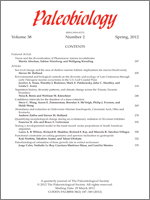The fossil record provides an important source of data on adaptive radiations, and indeed some of the earliest theoretical insights on the nature of these radiations were made by paleontologists. Here we focus on the diverse Devonian Metacryphaeus group calmoniid trilobites, known from the Malvinokaffric Realm, which have been considered a classic example of an adaptive radiation preserved in the fossil record. We use a geometric morphometric analysis in conjunction with phylogenetic and biogeographic patterns and data on speciation rates. Using ancestral character state reconstruction during speciation events, we quantify patterns of morphological change in order to assess the role ecological and geographical factors may have played in mediating this radiation. We found no significant differences between the amount of morphological change that occurred during speciation events when ancestors and descendants were in the same area as opposed to when they occupied different areas. Further, the magnitude of morphological divergence did not change through time or with cladogenetic rank. These patterns, in conjunction with the fact that the radiation occurs in a geographically heterogeneous region subjected to repeated episodes of sea-level rise and fall, suggest that at the macroevolutionary scale this radiation may have been motivated more by phenomena that facilitated geographic isolation than by competition.
How to translate text using browser tools
1 March 2012
Quantifying morphological change during an evolutionary radiation of Devonian trilobites
Francine R. Abe,
Bruce S. Lieberman
ACCESS THE FULL ARTICLE

Paleobiology
Vol. 38 • No. 2
Spring 2012
Vol. 38 • No. 2
Spring 2012




